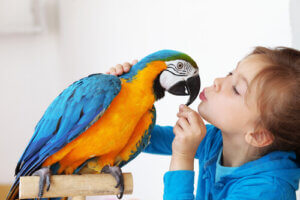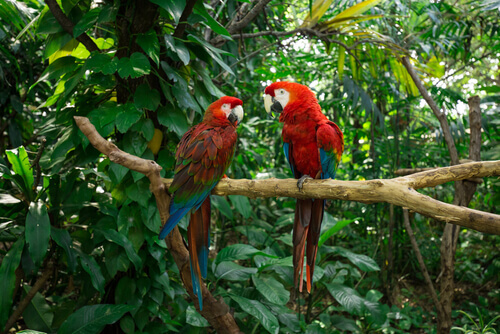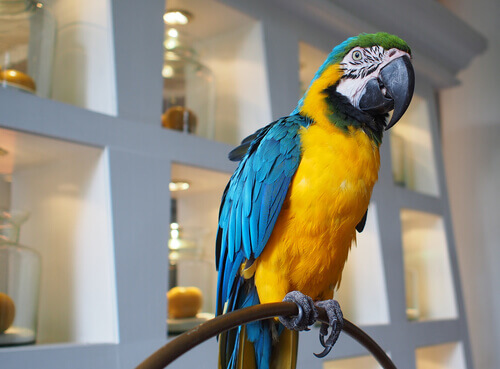Talking Birds: A Parrot's Behavior at Home


Written and verified by the lawyer Francisco María García
The domestic breeding of birds is an ancient practice, but it continues to gain followers even today. Parrots, for example, continue to be loved and admired for their privileged intelligence and remarkable sociability. In fact, a parrot’s behavior can be very surprising and they’re very favorable to training.
Nowadays we can find many breeders that specialize in domestic parrots. Undoubtedly, their exuberant beauty and remarkable intelligence have been crucial aspects for the survival of these species. But we mustn’t forget their extraordinary capacity to memorize and reproduce a great number of sounds.
It’s important to note that every country’s legislation has a list of exotic and wild species whose possession is considered illegal. Before choosing a bird as a pet, it’s therefore essential to consult this document. Unfortunately, wild animal trafficking is still in effect around the world and we must all cooperate to fight against it.
Up next, we’ll learn more about a parrot’s behavior and physical characteristics. In addition, let’s not forget that this is a bird that has charmed many generations of people.
A parrot’s behavior in the wild
In the wild, parrots are gregarious animals with a high level of sociability. This means that they form groups and live in communities harmoniously. Their gregarious tendency is even more intense in species such as the agapornis, the Argentinean parrot, and the Amazon parrot.

Gregarious life offers many advantages to parrots and contributes to their survival. Working as a community, they manage to ensure greater availability of food and stay well-nourished throughout the year. Gregarious birds usually maintain better quality and more nutritious diet than other species.
On the other hand, parrots share the responsibility of taking care of all the members of their group, mainly their chicks. Therefore, these species are usually less vulnerable to predator attacks than birds with solitary habits.
During the breeding season, parrots ‘economize’ on energy expenditure and the risk of migrating to find mates. Among the members of their community, they can mate safely and guarantee the continuity of their lineage.
Some species of parrots also adopt cooperative breeding, in which the parents are assisted by the others in raising their chicks. A whole life spent in the community, as you can see.
Parrot behavior at home
When bred in captivity, a parrot’s behavior may present some differences in relation to its wild state. However, intelligence and a high level of sociability remain the most outstanding characteristics of these species.
Adopting a parrot as a pet means preparing the home for the arrival of a new, highly communicative member. In the wild, parrots emit diverse sounds or calls, that is, they express themselves and communicate with their fellows through different vocalizations. However, they can also produce certain sounds just to entertain themselves. Fascinating, isn’t it?

In their home life, these species will be very sensitive, sociable, attentive, and energetic. Their intelligence and predisposition for training facilitate their learning and make them very friendly. However, a parrot that doesn’t exercise or receive a good education, can become quite a scandalous one.
Managing your parrot’s energy and intelligence
When the parrot is well-educated and entertained on a daily basis, it will maintain a more balanced behavior and will be able to learn more easily. Physical activity and mental stimulation are essential for a healthy life and can help prevent a lot of diseases.
To manage the energy and intelligence of their parrots, owners must provide them with the optimal conditions for their physical and mental development. Today we can find different toys and accessories to put inside their cages. As a result, this will allow them to exercise their cognitive, emotional, and social abilities.
A parrot will also require attention and will greatly enjoy the company of its masters and moments of family fun. Being such sociable animals, parrots can become seriously ill by living a solitary life.
In many species, loneliness can lead to self-destructive behavior, such as plucking their own feathers out or injuring their own skin. We must be on the lookout for signs of anxiety or stress in our birds.
In sum: parrots are very intelligent animals with a complex and fascinating psychological structure. The behavior of a parrot at home will depend fundamentally on the education and environment provided for it. In addition to adequate preventive medicine, owners should consider their need for physical and mental stimulation.
The domestic breeding of birds is an ancient practice, but it continues to gain followers even today. Parrots, for example, continue to be loved and admired for their privileged intelligence and remarkable sociability. In fact, a parrot’s behavior can be very surprising and they’re very favorable to training.
Nowadays we can find many breeders that specialize in domestic parrots. Undoubtedly, their exuberant beauty and remarkable intelligence have been crucial aspects for the survival of these species. But we mustn’t forget their extraordinary capacity to memorize and reproduce a great number of sounds.
It’s important to note that every country’s legislation has a list of exotic and wild species whose possession is considered illegal. Before choosing a bird as a pet, it’s therefore essential to consult this document. Unfortunately, wild animal trafficking is still in effect around the world and we must all cooperate to fight against it.
Up next, we’ll learn more about a parrot’s behavior and physical characteristics. In addition, let’s not forget that this is a bird that has charmed many generations of people.
A parrot’s behavior in the wild
In the wild, parrots are gregarious animals with a high level of sociability. This means that they form groups and live in communities harmoniously. Their gregarious tendency is even more intense in species such as the agapornis, the Argentinean parrot, and the Amazon parrot.

Gregarious life offers many advantages to parrots and contributes to their survival. Working as a community, they manage to ensure greater availability of food and stay well-nourished throughout the year. Gregarious birds usually maintain better quality and more nutritious diet than other species.
On the other hand, parrots share the responsibility of taking care of all the members of their group, mainly their chicks. Therefore, these species are usually less vulnerable to predator attacks than birds with solitary habits.
During the breeding season, parrots ‘economize’ on energy expenditure and the risk of migrating to find mates. Among the members of their community, they can mate safely and guarantee the continuity of their lineage.
Some species of parrots also adopt cooperative breeding, in which the parents are assisted by the others in raising their chicks. A whole life spent in the community, as you can see.
Parrot behavior at home
When bred in captivity, a parrot’s behavior may present some differences in relation to its wild state. However, intelligence and a high level of sociability remain the most outstanding characteristics of these species.
Adopting a parrot as a pet means preparing the home for the arrival of a new, highly communicative member. In the wild, parrots emit diverse sounds or calls, that is, they express themselves and communicate with their fellows through different vocalizations. However, they can also produce certain sounds just to entertain themselves. Fascinating, isn’t it?

In their home life, these species will be very sensitive, sociable, attentive, and energetic. Their intelligence and predisposition for training facilitate their learning and make them very friendly. However, a parrot that doesn’t exercise or receive a good education, can become quite a scandalous one.
Managing your parrot’s energy and intelligence
When the parrot is well-educated and entertained on a daily basis, it will maintain a more balanced behavior and will be able to learn more easily. Physical activity and mental stimulation are essential for a healthy life and can help prevent a lot of diseases.
To manage the energy and intelligence of their parrots, owners must provide them with the optimal conditions for their physical and mental development. Today we can find different toys and accessories to put inside their cages. As a result, this will allow them to exercise their cognitive, emotional, and social abilities.
A parrot will also require attention and will greatly enjoy the company of its masters and moments of family fun. Being such sociable animals, parrots can become seriously ill by living a solitary life.
In many species, loneliness can lead to self-destructive behavior, such as plucking their own feathers out or injuring their own skin. We must be on the lookout for signs of anxiety or stress in our birds.
In sum: parrots are very intelligent animals with a complex and fascinating psychological structure. The behavior of a parrot at home will depend fundamentally on the education and environment provided for it. In addition to adequate preventive medicine, owners should consider their need for physical and mental stimulation.
This text is provided for informational purposes only and does not replace consultation with a professional. If in doubt, consult your specialist.








